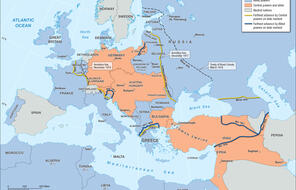From Religious Prejudice to Antisemitism
At a Glance
Subject
- Civics & Citizenship
- History
- The Holocaust
When Does "Us" Turn against "Them”?: Kwame Anthony Appiah
On July 3, 1871, a newly united Germany granted citizenship to all Germans “independent of religious denomination.” It was a moment of triumph for the approximately 500,000 Jews who lived in Germany at the time. But, as had so often been the case in many European societies for hundreds of years, Jews in Germany still did not have the same rights as other citizens. They were excluded from some occupations and denied high-ranking jobs in the army, some universities, and the upper ranks of the civil service.
Despite discriminatory laws and practices, however, many Jews in Germany prospered in the late 1800s. Those who prospered took advantage of the rapid mid-century growth of business, industry, and trade to find careers in new fields. They financed railroads, developed department stores, innovated in science and medicine, created theaters, founded newspapers and magazines, and experimented with new forms of music, art, and literature. Although they accounted for only 1% of the population and most were not wealthy, more Jews than ever were succeeding in Germany and becoming increasingly visible members of society.
But many Germans were disturbed by the changes in their society, and they felt that their traditional culture, status, and livelihoods were being threatened. It became appealing to accuse Jews of causing the transformation of German society that was disrupting their lives. Historian Saul Friedländer writes that for some Germans, “Jewish striving and Jewish success, real or imaginary, were perceived as the behavior of a foreign and hostile minority group acting collectively to exploit and dominate the majority.” 1
Wilhelm Marr, a German journalist, was among those who felt threatened by the progress Jews had made. In 1878, he published a pamphlet titled “The Victory of Judaism over Germandom.” It stated, in part:
There is no stopping them. . . .
German culture has proved itself ineffective and powerless against this foreign power. This is a fact; a brutal [inescapable] fact. State, Church, Catholicism, Protestantism, Creed and Dogma, all are brought low before the Jewish tribunal, that is, the irreverent daily press [which the Jews control].
The Jews were late in their assault on Germany, but once they started there was no stopping them.
Gambetta, Simon, and Crémieux were the dictators of France in 1870–1871. . . .
Poor, Judaized France!
In England, the Semite Disraeli [Prime Minister Benjamin Disraeli], a German hater . . . , holds in his vest pocket the key to war and peace in the Orient [the East]. 2
The pamphlet was filled with lies and exaggerations. Jews did not control the press anywhere. Although Crémieux was a Jew and France’s minister of justice, he was neither a dictator nor a head of state. Léon Gambetta, the president of the French Chamber of Deputies in 1879, and Jules Francois Simon, the minister of education in 1870, were neither dictators nor Jews; both men were Christians. As for England, Marr referred to Prime Minister Benjamin Disraeli, who belonged to the Anglican Church, as a “Semite” because Disraeli was born to Jewish parents.
Such facts were irrelevant to antisemites. To Marr and a growing number of other Europeans, all Jews, regardless of their religious beliefs, belonged to the “Semitic race.” In the late 1800s, many European and American scientists continued to divide humankind into smaller and smaller “races,” one of which was the “Semitic race.” (The word Semitic does not actually refer to a group of people but is a linguistic term that refers to a group of languages traditionally spoken in the Middle East and parts of Africa, including Amharic, a language spoken in Ethiopia, as well as Hebrew and Arabic.)
Marr viewed Jews as more than just members of a distinct “race.” In his view, the “Semitic race” was dangerous and alien. He coined the term antisemitism to describe his racial opposition to Jews and founded the League of Antisemites in Berlin in 1879 to combat the threat he imagined they posed. The group tried to turn antisemitism into a popular political movement. It never attracted many members, but another political party—the Christian Socialist Workers’ Party, founded a year earlier by Protestant theologian Adolf Stoecker—had more success.
At first Stoecker’s party focused on the social effects of industrialization and the need for Germans to rededicate themselves to Christianity. Antisemitism was a relatively minor theme until the party’s leaders discovered they could increase their membership by demanding that German Jews renounce their alleged dreams of ruling Germany and by calling on the government to further limit the number of Jews in certain professions and universities. Like Marr, Stoecker and his followers were convinced that modern “science” justified discrimination against Jews.
By the end of the century, antisemitism had found a home almost everywhere in Europe. Every country interpreted racist ideas a little differently. Scientists who showed that more differences existed within a so-called race than between one “race” and another were ignored. So the myth that Jews were a race continued to grow throughout Europe.
- 1Paul Friedländer, Nazi Germany and the Jews, Volume 1: The Years of Persecution, 1933–1939 (New York: HarperCollins, 1997), 82.
- 2Wilhelm Marr, “The Victory of Judaism over Germandom,” in The Jew in the Modern World: A Documentary History, 2nd ed., ed. Paul Mendes-Flohr and Jehuda Reinharz (Oxford, UK: Oxford University Press, 1995), 331–32.
Antisemitism from the Enlightenment to World War I
Connection Questions
- In 1871, Jews were guaranteed citizenship in Germany, but they still did not have the same rights as other citizens. Were they members of the German nation? Were they part of Germany’s universe of obligation?
- Why do you think Jews were targeted in Germany in the 1870s? Was their success in German society related to efforts to exclude them?
- How did Wilhelm Marr apply ideas of “race” to Jews? How did “race science” support his views? What were some consequences of his ideas? How did antisemitism spread in Germany?
- What makes a myth so powerful that it continues to exist even when it is not supported by factual evidence?
How to Cite This Reading
Facing History & Ourselves, "From Religious Prejudice to Antisemitism," last updated August 2, 2016.














